Turning Leads into Customers: The Role of Email Marketing
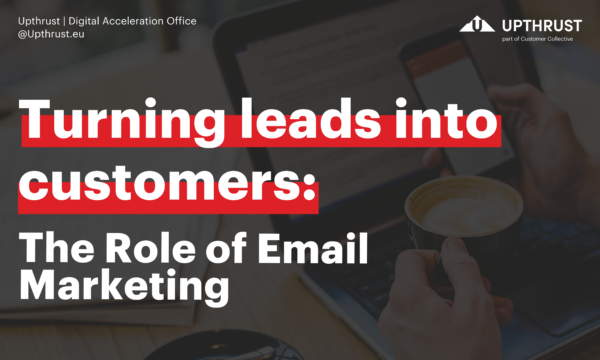
In the digital age we live in, email marketing has become a powerful tool for businesses to get their message across. Despite the rise of social media and other online communication platforms, email remains a personal and direct way to connect with customers. But how do you ensure your emails stand out in a crowded inbox? In this blog, we’ll delve deeper into the world of email marketing, sharing best practices and tips to take your email campaigns to the next level.
What is Email Marketing?
In the current era of digital technology, among a variety of marketing channels, email marketing remains steadfast. So, what does it mean?
Email marketing involves sending well-crafted emails to a particular audience as part of a strategic approach. However, it’s not just about overloading inboxes with promotional communications. Instead, it’s a delicate craft of constructing and fostering relationships, generating sales, and intensifying customer loyalty. By combining valuable content and relevant offers, businesses can connect with their existing customers and potential leads in a meaningful manner.
Furthermore, the right email marketing tool can significantly simplify this process, enabling better targeting, tracking, and refining of strategies. Not only is content crucial, but even elements such as an engaging subject line can either make or break whether your email is opened or ends up in the spam folder.
As you start or carry on with your email marketing journey, remember that it’s a lively mix of planning and correspondence. When implemented correctly, it’s one of the best means to connect with your audience in the digital world.
Why is it important?
In the big world of digital marketing, email marketing shines as a potent strategy. But what makes it so crucial?
- Directly Speaking to the Target Audience:
- Email marketing enables companies to communicate directly with their intended audience. Additionally, by using email marketing tools, businesses can personalize their messages to specific segments, guaranteeing the delivery of pertinent content to suitable individuals.
- Increasing Customer Loyalty:
- Regular marketing emails can build customer loyalty. Moreover, by sending useful content and offers straight to their inbox, businesses can develop potential customers and transform them into loyal supporters.
- High Return on Investment:
- Email marketing is one of the top-performing marketing channels; it gains significant returns on investment. Through a successful email marketing campaign, companies can easily boost sales and revenue.
- Flexibility and Versatility:
- Email campaigns can be versatile, accommodating many business needs. They can include promotional and transactional emails such as newsletters, sale announcements, and thank you notes.
- Measurable Results:
- Email platforms give important data like click rates, allowing marketing managers to measure the email campaign’s achievement. This data-driven approach guarantees optimal performance and lets businesses fine-tune their tactics.
- Personalization and Automation:
- With the latest developments in email marketing software, businesses can use email personalization to make their messages more meaningful to each recipient. Additionally, email automation guarantees prompt communication without requiring continual manual supervision.
- Avoiding the Spam Folder:
- An effective email subject can boost the likelihood of an email being opened. However, it is essential to steer clear of sending unrequested emails, as they can damage a brand’s image and email marketing campaign.
- Integration with Other Marketing Channels:
- Email marketing can work alongside other marketing channels. For example, a blog post can be advertised through an email, or a special offer can be shared on both an online shop and an email campaign.
- Growing a Subscriber Base:
- Opt-in and signup forms on websites and landing pages help businesses expand their email subscribers list. By providing useful content or exclusive offers, businesses can persuade visitors to subscribe, boosting the potential for future sales.
In essence, email marketing is more than a marketing channel. It’s an effective, versatile, and outcomes-focused approach that has endured. As online spaces get busier, having a direct link to your audience’s inbox is hugely valuable.
The Unbeatable Advantages of Email Marketing
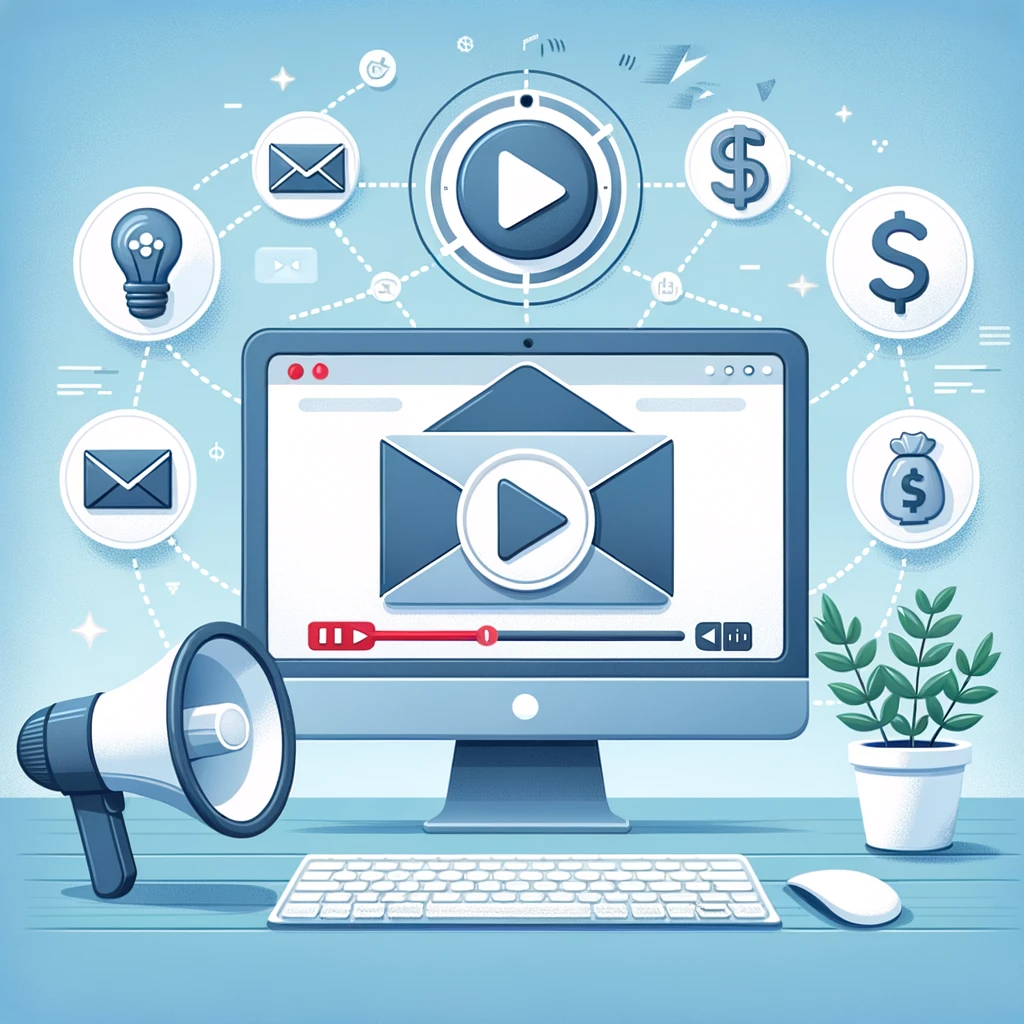
Picture this: ou have just opened your inbox, and amid the numerous unread emails, one catches your attention. Additionally, the subject line speaks to you, almost as if the email knows what you have been searching for. You click, and the content inside is not merely pertinent; it seems personalized and specially suited to you. That’s the power of a successful email marketing campaign. But what is it that makes email marketing so effective? Let’s explore:
Direct Line to Your Audience: Emails go straight into your audience’s personal inbox, making it an intimate and direct marketing channel. When executed correctly, emails can be incredibly effective.
Cost-Effective: With a suitable email marketing tool, even the tiniest businesses can lead successful email campaigns without spending much money. It is advantageous in terms of impact and cost-effectiveness, so don’t miss out on this opportunity.
Measurable Results: Curious about how well your most recent email marketing campaign fared? Email marketers can use click-through rates, among other metrics, to measure the effectiveness of their marketing campaigns and optimize their methods.
Personalized Content: Personalized emails have surpassed generic marketing emails. By personalizing your messages, your subscribers will feel valued and understood, leading to a stronger connection between them and your brand.
Mobile-Friendly: As numerous people use their mobiles to access emails, a responsive email layout guarantees your message will appear first-rate on any screen size.
Builds Strong Relationships: By providing useful information, special offers, or informative newsletters, you are not only making sales; you are creating faith and cultivating customer allegiance.
Flexibility: Promoting a new product? Announcing a sale? Sharing a blog post? Emails can cater to various objectives, seamlessly integrating with other marketing channels.
Avoiding Pitfalls: A carefully written email avoids the unwanted spam folder, allowing your message to reach its intended recipients. Plus, there are tools available to circumvent spam filters, giving you peace of mind.
Immediate Results: Emails can encourage immediate actions. A compelling request can guide a reader directly to your online shop, increasing sales.
In today’s digital world, there are many marketing approaches to choose from, but email marketing stands out with its undeniable benefits. Whether you’re a beginner or improving your tactics, remember an effective email has the power to convert a simple subscriber into a loyal customer.
Strategies for Effective Email Marketing
As more businesses move to digital platforms, effective communication becomes essential. Furthermore, email marketing, one of the longest-lasting and most powerful channels, gives brands the chance to connect with their audience by sending personalized content to their inbox. However, with people receiving so many emails every day, brands need to be strategic to get noticed. In this section, we’ll look at key tactics to guarantee that your email marketing efforts reach the right people, grab their attention, and incite action.
1. Refine Your Email List for Optimal Email Marketing Campaigns
One of the most important email marketing efforts is refining your contact list. By eliminating dormant email addresses or those who unsubscribe, you ensure that your email service provider is sending out messages to genuinely interested parties. Regularly updating your list not only amplifies your email marketing strategy but also enhances your sender reputation, ensuring a higher chance of bypassing spam filters and reaching the recipient’s main inbox
2. Deliver Consistent Value: The Core of Every Successful Email Marketing Campaign
Every mail sent should offer undeniable value to its recipients. Understanding and addressing your customers’ pain points is paramount. For instance, if you run an online store addressing common challenges like sizing or product quality can be invaluable. Offering relevant content, such as interactive size guides or product care tips, can make your promotional emails stand out from the plethora. Use opt-in forms to get feedback and understand what your subscribers genuinely want.
3. CTA’s: The Heartbeat of Conversion in Email Campaigns
Your call to action (CTA) can make or break your email marketing campaign. It’s not just about having a button; it’s about compelling your readers to click on it. Words matter! Phrases that instill urgency, like “Limited Time Offer,” or tap into the fear of missing out (FOMO), can significantly boost your click-through rates.
4. Harness the Power of User-Generated Content (UGC)
UGC not only enhances customer loyalty but also provides genuine endorsements for your brand. Featuring customer testimonials, reviews, or even user-posted photos in your marketing emails can significantly amplify trust. Encourage this by creating hashtag campaigns on social media or offering incentives for customer reviews.
5. Unify Social Media and Email: Dual Marketing Channels for Maximum Reach
Integrating social media into your email marketing platform can exponentially expand your brand’s reach. Additionally, promote cross-channel engagement by including social media buttons in your emails. With tools like Brevo, sharing email content on social platforms is seamless, turning your email subscribers into potential social media followers and vice versa.
6. Subject Lines: The First Impression Counts
Crafting a compelling email subject line can significantly boost your open rates. With the deluge of marketing emails recipients receive daily, your email has to stand out. Personalizing subject lines, keeping them concise yet intriguing, and ensuring they resonate with the email’s content can yield better results.
7. Strategic Segmentation: Tailoring Emails to Your Target Audience
By segmenting your email list, you ensure that your email campaigns resonate more with recipients. Whether it’s based on demographics, past purchasing behavior, or how they joined your list (e.g., through a specific landing page), segmentation allows for more tailored and effective email marketing campaigns.
8. Reignite the Spark: Re-Engaging Dormant Subscribers
Existing customers are gold mines. Re-engaging them, reminding them of your brand’s value, and possibly offering exclusive incentives can revitalize their interest. Craft your re-engagement campaigns to remind them why they subscribed in the first place.
9. Automation at Its Best: Trigger-Based Campaigns
Trigger-based emails, driven by specific user actions, offer timely and relevant touchpoints. Whether it’s a follow-up on a viewed product, a reminder of an abandoned cart, or a thank you note post-purchase, these emails enhance the user experience and often drive sales.
Nurturing Leads with Email Campaigns
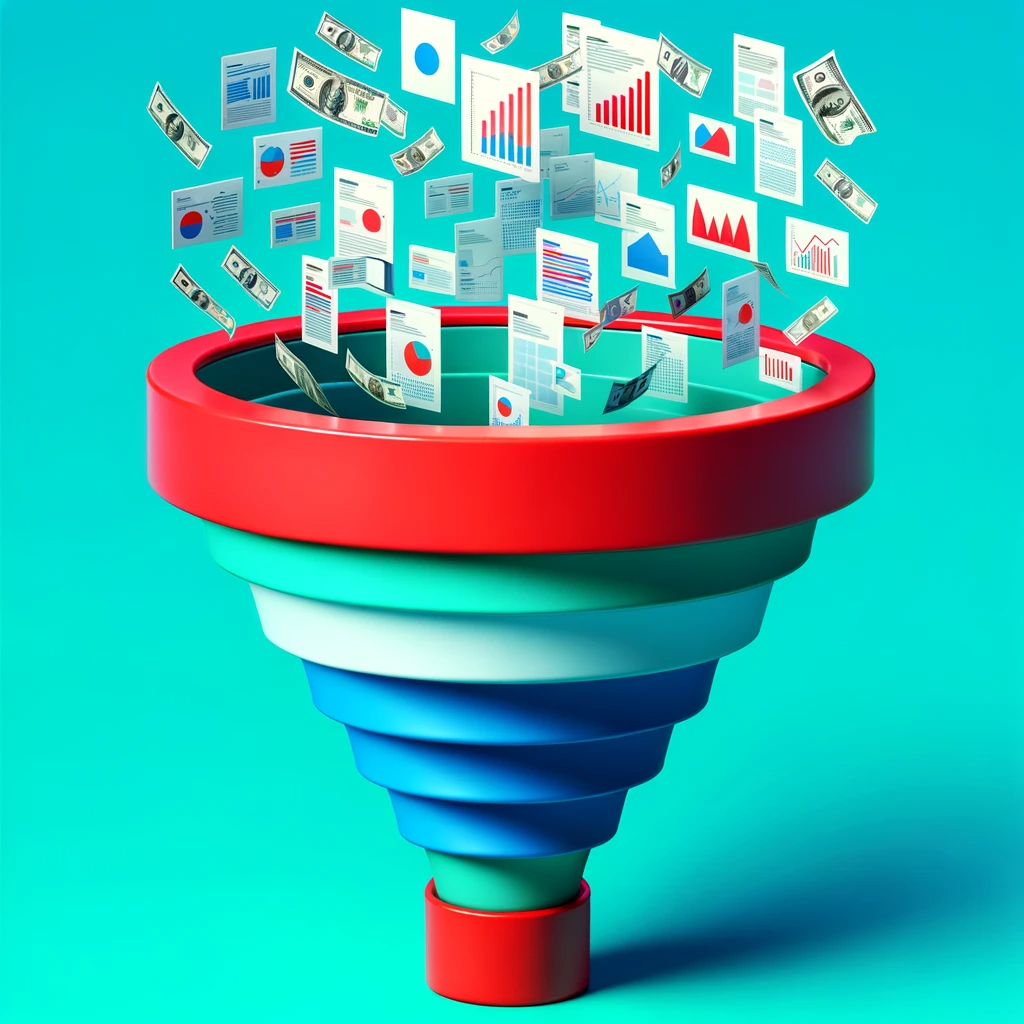
The importance of connecting with audiences and creating opportunities is understood by every savvy marketer.
This is an extensive undertaking that demands bespoke campaigns developed using information, analysis and exploration.
Lead nurturing is undeniably a crucial tactic for transforming opportunities into conversions, and it is, in fact, one of the most fruitful techniques for attracting fresh audiences.
In fact, 69% of marketers consider lead generation to be their primary marketing goal.
Lead nurture campaigns increase awareness of a brand. They inform potential customers about a brand, its products and its services. The purpose of a lead nurture campaign is to build trust and persuade customers to choose one brand over another.
Email campaigns that are targeted at potential leads are, without a doubt, the best way for marketers to attract new customers, drive traffic, and secure conversions.
What is Lead Nurturing?
Lead nurturing is when businesses offer resources and information to potential customers, encouraging them to move through the sales process until they are ready to make a purchase. Sales representatives catch the attention of potential customers with helpful materials, and then build a stronger relationship with them by showcasing how their products or services can solve their needs. By addressing crucial issues, businesses can convert potential customers into loyal ones.
The Difference Between B2B & B2C Lead Nurture
B2B Lead Nurturing
B2B lead nurturing focuses on companies or professionals. Its goal is to meet their specific business needs. These interactions often take longer because many people are involved in making decisions. Therefore, the nurturing process could be longer. Content depth matters to B2B audiences as they appreciate in-depth, relevant content that tackles industry challenges or offers solutions. Customized email campaigns that address the individual pain points of companies are a great way to enhance interaction and engagement. Building and maintaining trust and credibility is vital when working with other businesses. Consistent, value-focused marketing emails significantly contribute to establishing trust and credibility. Additionally, B2B nurturing frequently goes beyond emails and incorporates other marketing channels like webinars or industry events.
B2C Lead Nurturing
On the other hand, B2C email marketing exclusively targets particular customers. In these marketing campaigns, the feelings and desires of the customer have a crucial part to play. Aiming to provoke the emotions of the target audience and make them act on specific offers or narratives for the purchase, B2C messages remain highly effective. Also, the sales cycle in B2C marketing is shorter, and impulse, need, or immediate desire are the primary influencers of the consumer’s buying decision. In the consumer world, marketers commonly aim for a wider and more varied audience, resulting in larger email campaigns. Discounts, promotions, and limited-time offers are typical techniques in consumer email marketing plans. Because people often check emails on their mobile devices, it is crucial to make sure the email content is mobile-friendly for consumer campaigns.
Common Ground
Although B2B and B2C lead nurturing greatly differ, they share certain similarities. Valuable content delivery, whether it’s in the form of a blog post, product guide, or promotional message, is crucial for both markets. It is vital to prevent marketing emails from going into the spam folder, which requires grasping spam filters, creating captivating subject lines, and employing reliable email service providers. Tools and platforms, like email automation and analytics, are essential in both B2B and B2C campaigns. Metrics, such as click-through rates and conversion rates, help refine email marketing efforts and ensure optimal ROI for marketers.
Conclusion
Overall, while the core of lead nurturing is consistent between B2B and B2C – building relationships and guiding potential customers towards purchasing – their strategies and tactics may vary. Recognising and understanding these subtleties is crucial for marketers who aspire to form efficacious email marketing campaigns tailored to their particular target audience. By utilizing the right methods and techniques, enterprises can efficiently sustain their leads, propelling progress and triumph in their respective fields.
What is An Email Nurture Campagne?
An email nurture campaign is a set of emails that are sent based on a lead’s actions. Additionally, these emails provide helpful and relevant info to help guide the lead towards buying your product. Moreover, as the lead gets your emails, they will learn more about your product.
Specific data about how the lead interacts with your website, like how many times they visited it, which articles they read, and what seminars they signed up for matter a lot in nurture campaigns. The aim is to provide informative content to potential customers while stimulating their interaction with your materials. The nurture campaign is initiated by these actions, which is distinct from drip marketing and designates a more personalized distribution timetable.
Here are 6 examples of highly effective nurture emails
#1 Welcome new customers
This is a welcome email to new subscribers from Casper, the mattress company. Casper claims to help its customers fall and stay asleep. That’s why the company chose to focus on sleep-related language for this email.The simple, useful design cleverly incorporates the sleep concept of the email. The welcome email is effective as it showcases Casper’s community, which comprises of one million people, a clear indication that Casper is a dependable brand.The Call To Action (CTA), “Let’s get sleepy,” is also a smart reference to Casper’s brand identity, which focuses on assisting people to sleep better. When the email recipients click on the CTA, they get access to an array of content from Casper about sleep hygiene. Instead of aggressively marketing its products, Casper offers helpful content to address its customers’ concerns and build stronger connections with subscribers

#2 Customer milestone celebrations
Customer loyalty is an invaluable cornerstone of your business – it’s important to nurture it. Sending anniversary recognition emails can reinforce a subscriber’s loyalty to your brand. Take this gesture from Grammarly, for example, which demonstrates the simplicity of commemorating each customer’s journey with your company. While simply acknowledging the anniversary can build loyalty, the effectiveness of this email is amplified by offering a discount on a Vimeo upgrade. With a 10% discount on the premium version and the “Save 10% on Plus” CTA, it makes the decision to upgrade easy for existing users. In addition, the inclusion of social media sharing buttons allows customers to broadcast their Vimeo anniversary, giving the brand organic visibility at no additional cost.
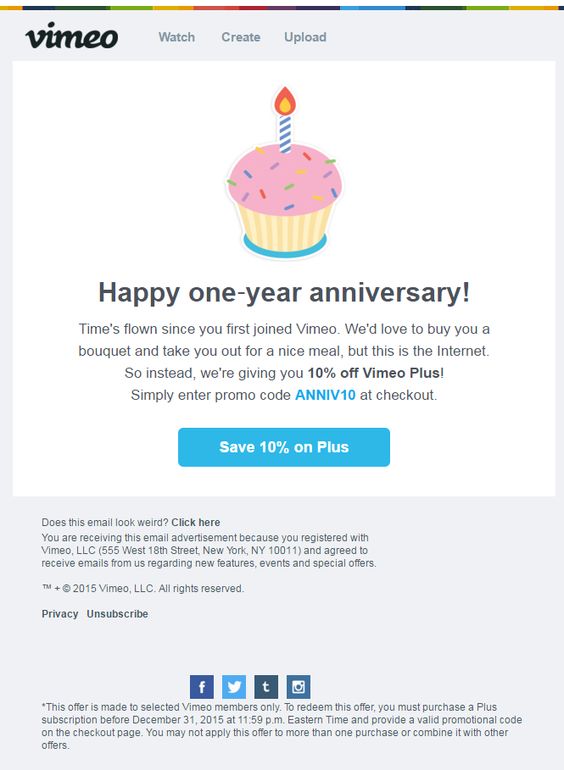
#3 Offer new customers a discount
Around three quarters of customers open emails just to look for discounts. If you want to increase open rates and conversions, consider a nurture campaign like this one from Barnes&Noble, an American company that sells books, magazines, toys, movies etc. While this isn’t normally a cheerful service, the high cost of writing a will makes the discount promising, especially for Barnes&Noble’s new subscriber list. The Barnes&Noble discount email works beautifully because the discount expires quickly.
Barnes&Noble’s time-limited discount code creates urgency. Their green “Take an extra 15% off” button highlights the CTA, prompting subscribers to act.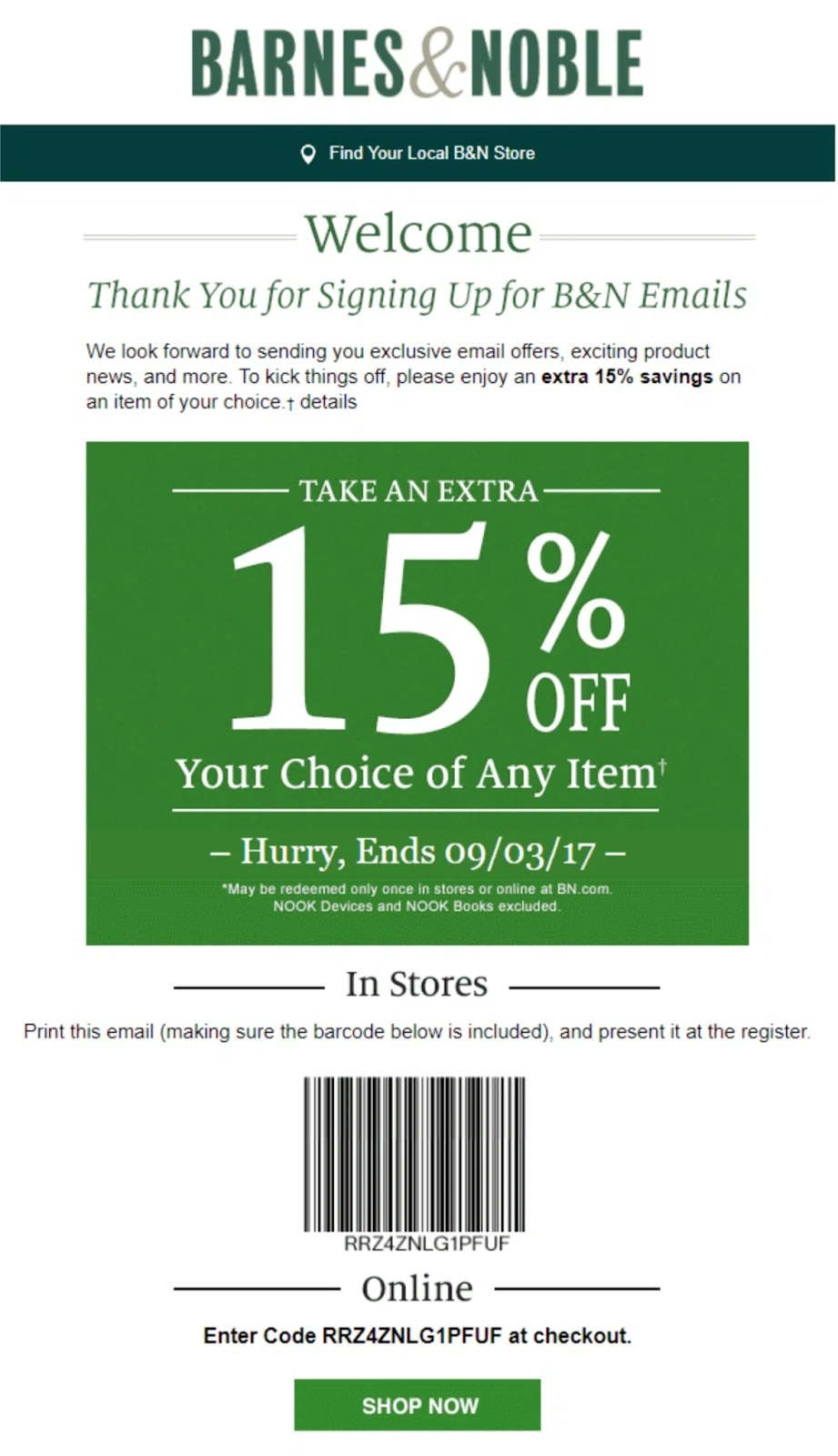
#4 Product tutorials to inspire and educate customers
Whether you run a B2B or B2C business, customers will appreciate informative emails that help them get more value from your offerings. Baggu is a reusable bag company that sent an educational email to customers showing them how to care for their Baggu products. In this email, Baggu provides simple tips to help customers get more life out of their bags.Instead of creating a text-heavy message that many subscribers might not read, Baggu created a visual, infographic-style email. Its simple icons and headers quickly tell customers how to get more out of their Baggu products without having to read through a long list of instructions.
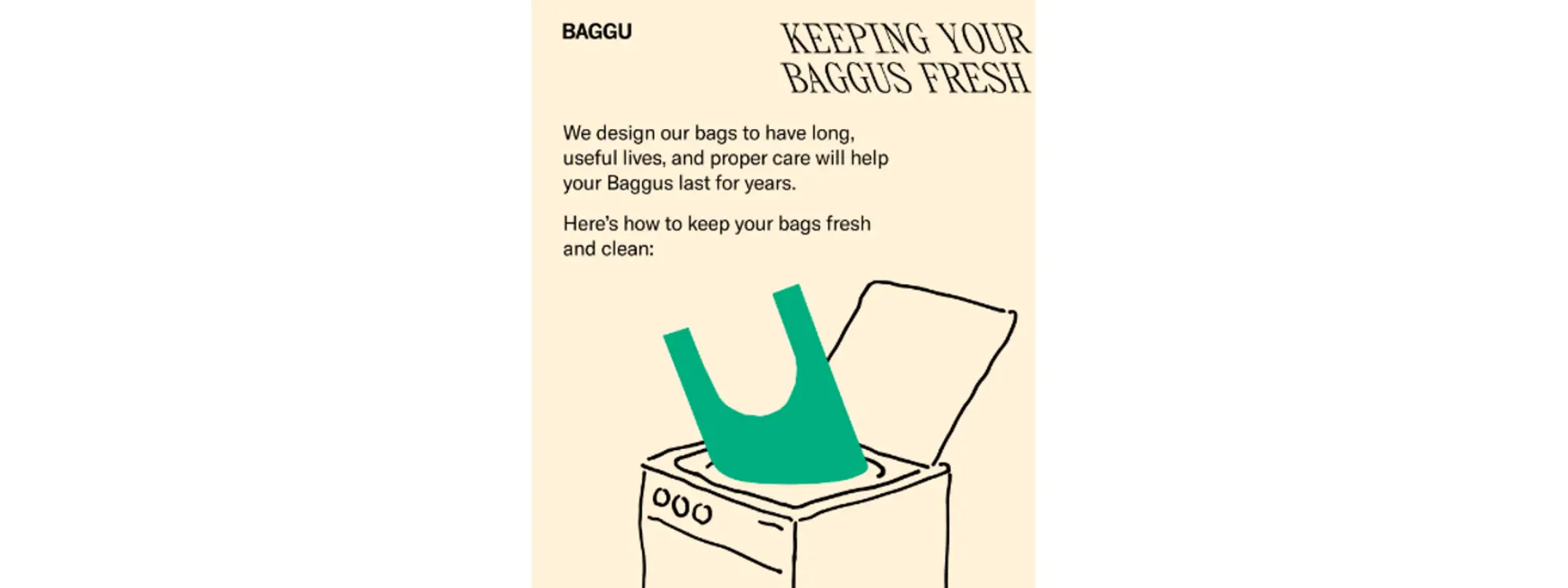
#5 New product announcement
Chubbies is a company that makes men’s clothes and is famous for its interesting humour. In an email announcing their new product, Chubbies used a fun way of talking and new features to make subscribers excited about their new range of shorts.This email works because it tells subscribers about the shorts in a way that’s like a friend telling you about their new clothes. It also uses unique features, such as hand embroidery, to inform customers in a subtle way about why Chubbies shorts are superior to other choices available on the market.Additionally, the amusing and striking image of the product attracts more attention.

#6 The “selected items” email
Having too many options can be a bad thing. Furthermore, it can make buyers doubt their choices or feel regretful about their decisions. In some cases, they may even become so overwhelmed that they give up on making a purchase altogether. However, offering subscribers a curated product selection can turn browsers into buyers. For instance, ‘Everything Just Baked,’ a Black-owned bakery, guides customers with a handpicked assortment of baked goods.
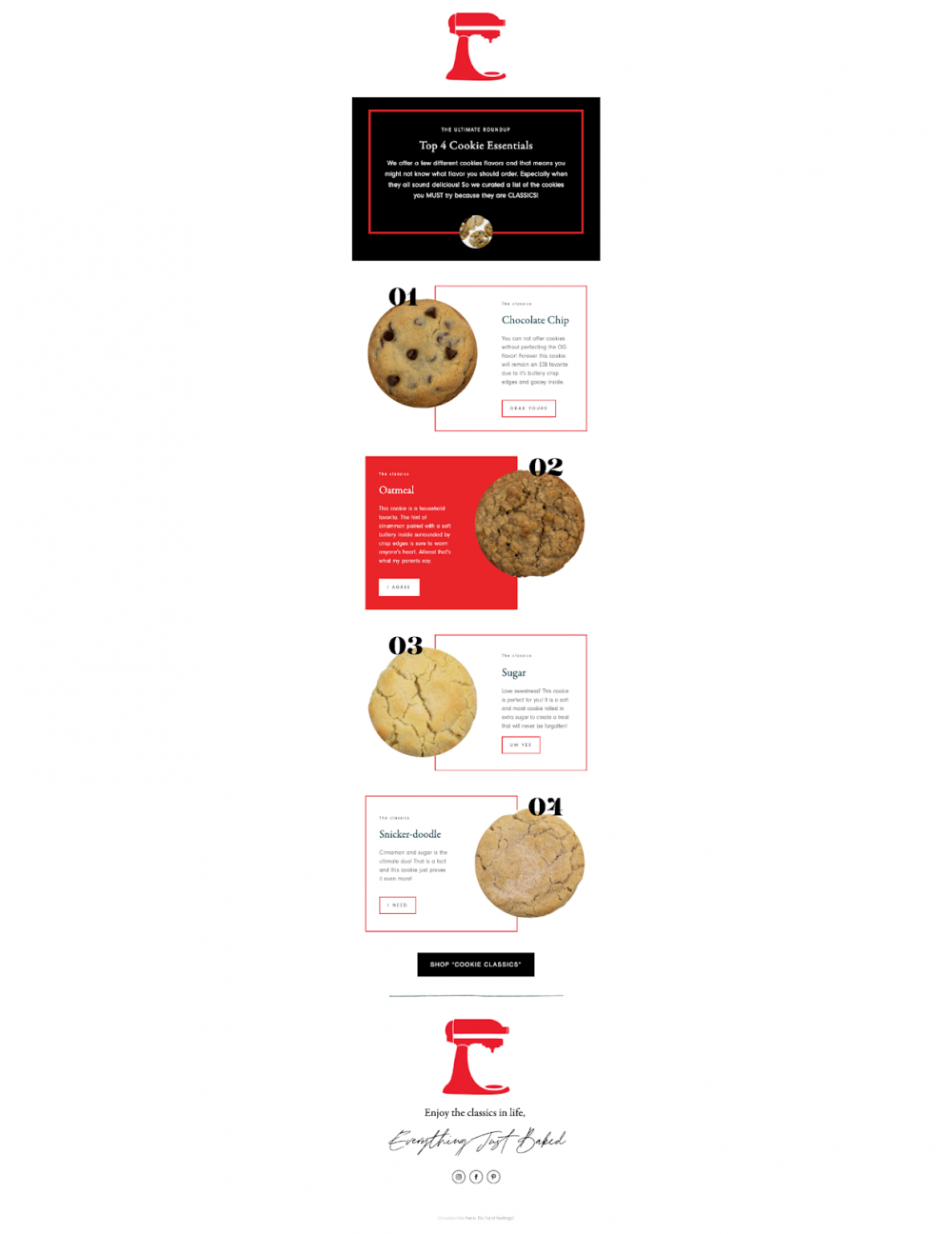
5 Essential Tools to Use
#1 – Brevo
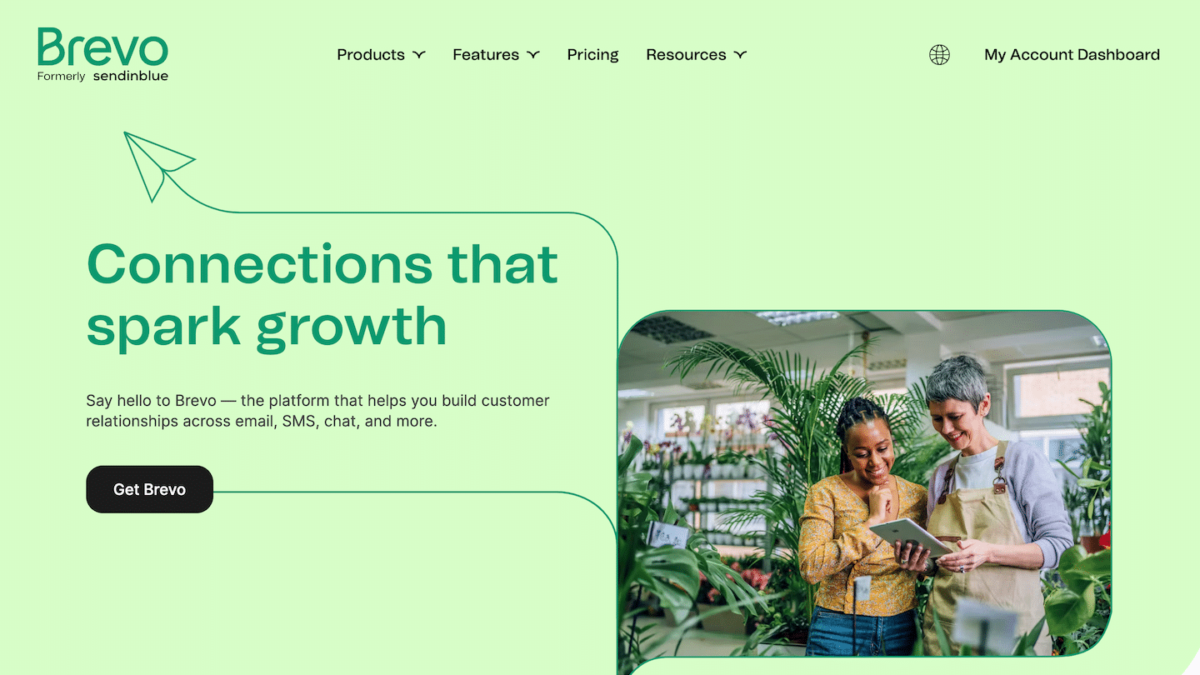
Used by over 500,000 businesses, Brevo offers key marketing tools including Email, Automation, SMS, Chat, CRM, Landing Pages, and a Shared Inbox.
Moreover, use these tools to interact with your contacts and form stronger customer connections through bespoke communication. You have unlimited contact storage and a forever-free plan enabling 300 emails per day. Alternatively, upgrade to a simple pricing model based on your monthly email volume to unlock more features.
Pricing:
Free plan: Acces our services for free and send up to 300 emials daily. Enjoy customizable templates, an easy drag & drop editor, and the ability to run SMS & WhatsApp campaigns.
Starter Plan (from €19/month): Send over 20,000 emails without daily limits. Enhance your branding without the Brevo logo and utilize basic analytics with responsive email support.
Business Plan (from €49/month): Upgrade for advanced features like marketing automation and A/B testing. Delve into comprehensive statics, collaborate with multi-user access, and reach out directly via phone support.
#2 – Mailchimp
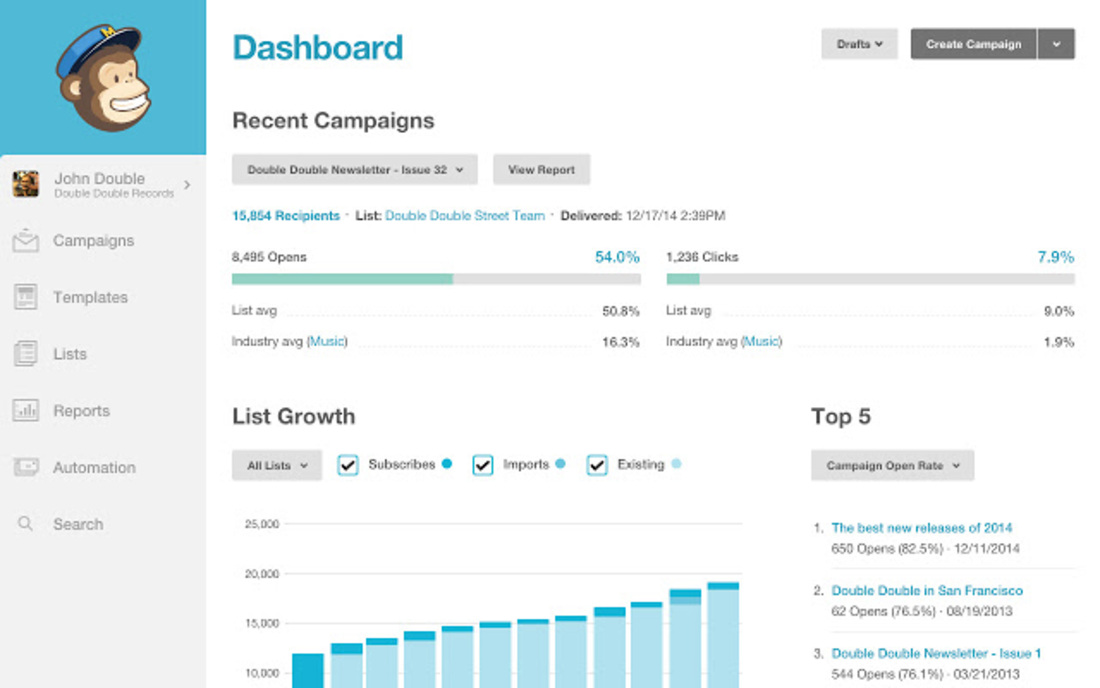
MailChimp has long established itself as a leading email service provider in the realm of email marketing. With its free tier, albeit with some limitations, it offers an effective platform for beginners to embark on their email marketing campaigns. This user-friendly email marketing tool allows users to generate lists, add subscribers, personalize emails, and monitor their email marketing efforts, all from a singular hub.
Furthermore, MailChimp aids in optimizing your CTAs to better capture your target audience and increase subscribers. Their extensive library of email newsletter templates makes it easy for marketers to craft engaging and valuable content that resonates with their audience, thereby reducing the chances of emails landing in the spam folder. For those looking to elevate their email marketing strategy, MailChimp also offers advanced features like email automation and A/B testing, solidifying its position as an essential tool in every digital marketing toolkit.
Pricing:
Free: Begin with Mailchimp at no cost, supporting up to 500 contacts and 1,000 monthly emails. This starter package includes basic features and email support for the initial 30 days.
Essentials Plan: At €12.37/month post a trial month, the essential plan caters to 500 contacts and allows 5,000 monthly emails. It boosts user access and offers 24/7 email and chat support.
Standard Plan: Prices at €19.03/month post at trial month, the Standard package serves 500 contacts with a limit of 6,000 emails monthly. It extends user access, provides diverse audiences, and maintains round-the-clock support.
Premium Plan: For larger operations, the Premium tier starts at €333.01/ month, supporting 10,000 contacts and 150,000 monthly emails. This comprehensive plan includes unlimited user access, several advanced features, and prioritized support.
#3 – Hubspot
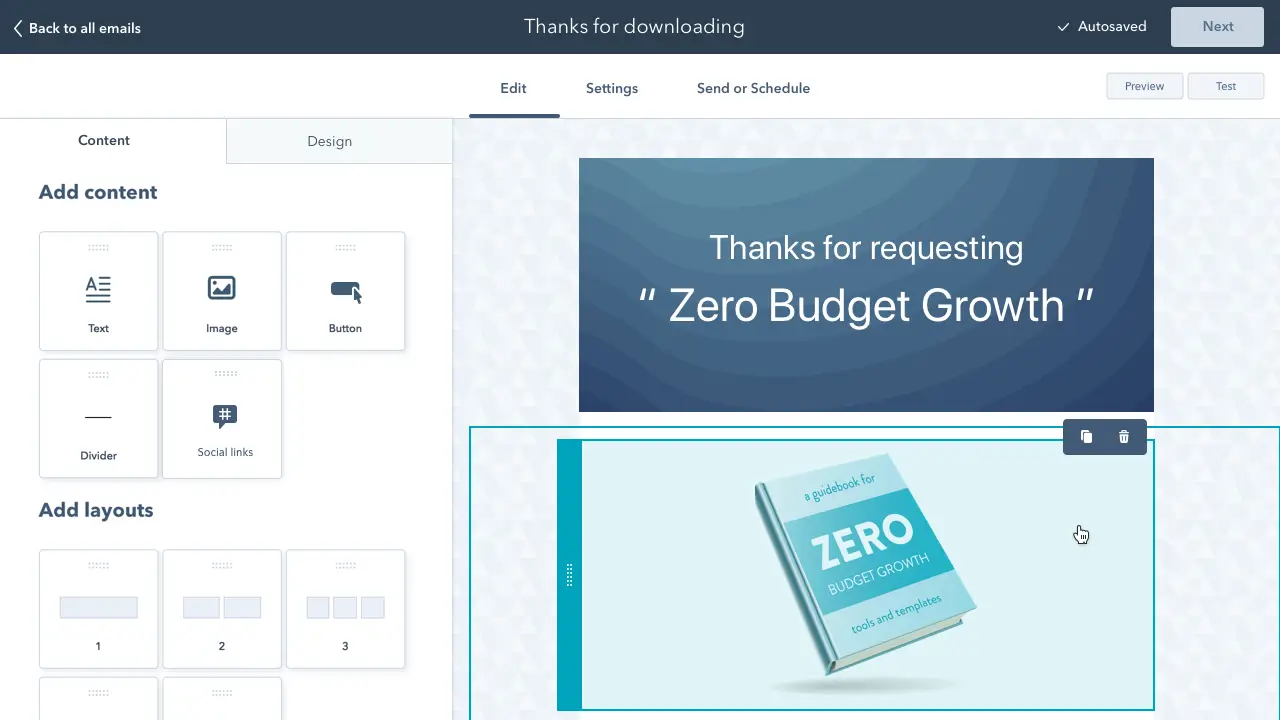
Crafting marketing emails can be a delicate balance between personalization and relevancy. Often, marketers tread this tightrope lacking support, relying on external designers or IT. But with HubSpot’s email marketing tools, the power to create impactful email marketing campaigns lies directly in your hands.
This email marketing platform, a renowned email service provider, offers a suite of tools that ensures your email marketing efforts are not just another message heading to the spam folder. Powered by the HubSpot CRM database, the accuracy of data means that promotional emails can be tailored to resonate with the target audience. As an added advantage, HubSpot provides email automation features, ensuring that each email campaign aligns perfectly with your overall digital marketing strategy. With HubSpot, you’re not just sending emails; you’re crafting valuable content that speaks directly to your subscribers, fostering customer loyalty and driving sales.
Pricing:
Professional Plan: Starting at €792/month (billed annually at a discounted €9,49), the Professional package offers comprehensive marketing tools for automation, reporting, and campaigns, suitable for up to 2,000 marketing contacts. It enhances the Starter features with custom reporting, team management, omni-channel marketing automation, campaign reporting, and social media capabilities.
Enterprise Plan: Priced at €3,300/month, the Enterprise tier provides advanced control and flexibility for up to 10,000 marketing contacts. Building upon the Professional features, it introduces custom behavioral events, advanced content and data access control, organizational tools for teams, multi-touch revenue attribution, and custom object handling.
#4 – Omnisend
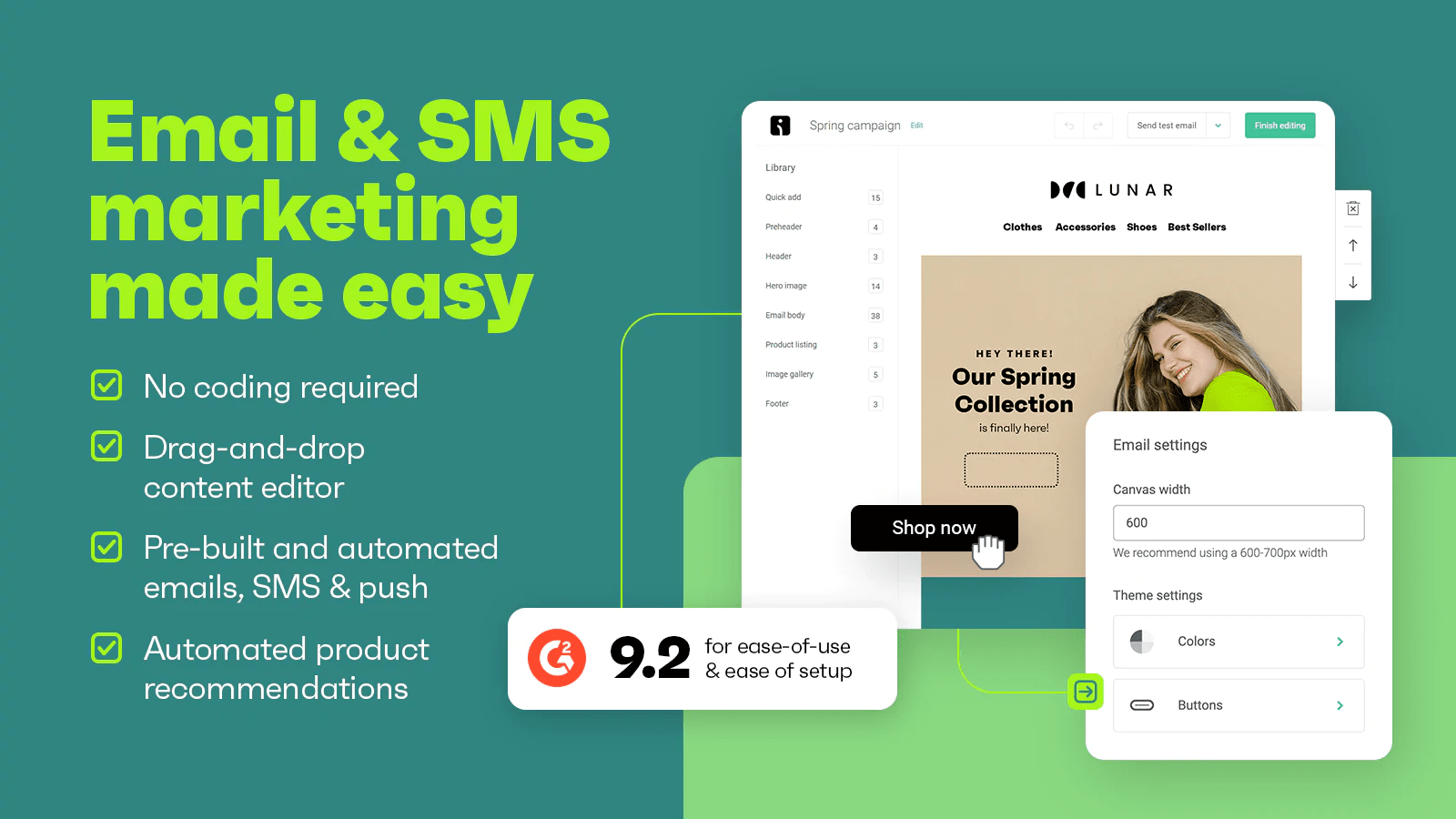
Omnisend stands out as a premier email service provider, offering a potent blend of robust features with a user-friendly interface. As an all-encompassing email marketing tool, Omnisend supports email marketers in crafting successful email marketing campaigns, backed by a vast array of templates tailored to both emails and automation workflows. The platform’s drag-and-drop visual builder, combined with its email capture tools, ensures the creation of marketing emails that resonate with the target audience.
Omnisend uniquely integrates multiple marketing channels into one automation workflow. In addition, this includes traditional email campaigns, SMS, push notifications, and even messaging services like Facebook Messenger and WhatsApp. This multi-faceted approach ensures that your email marketing efforts effectively engage and nurture leads, drive sales, and bolster customer loyalty. Whether you’re optimizing subject lines or crafting relevant content, Omnisend’s features empower you to elevate your digital marketing strategy.
Pricing:
Free Plan: With Omnisend branding, access numerous features like unlimited sign-up forms, landing pages, segmentation, and website tracking with 1 month of historical data. Cater to up to 250 contacts with 500 emails monthly at no charge.
Standard Plan: Beginning at €16/month for 500 contacts (providing 6,000 emails), this plan offers enriched features without Omnisend branding. It covers extended 6-month website tracking, live chat support, and extends to €330/month for 50,000 contacts, allowing 600,000 emails.
Pro Plan: Targeting businesses needing superior functions, the PRO plan starts at €59/month for 500 contacts with unlimited emails. It encompasses an 18-month website tracking period, custom domain signature, and a dedicated account manager from 27K contacts. The plan scales to €650/month for 50,000 contacts, giving unlimited emails.
#5 – SendPulse
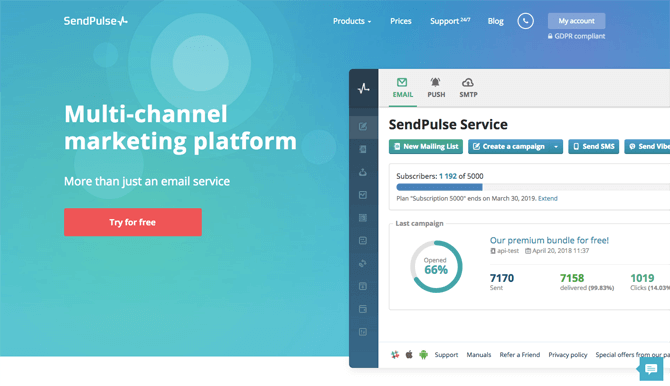
SendPulse is a leader in digital marketing, offering much more than just email marketing. This platform offers email marketing tools and also automates SMS, Web Push, and chatbot campaigns.
SendPulse let’s you craft unique subscription forms, explore vibrant email templates, run A/B tests, and, once more, understand your audience through segmentation. Furthermore, it’s not just a tool; it’s about forging connections. Additionally, many of these features come with a free plan, making it a budget-friendly choice for businesses exploring email marketing.
Pricing:
Free Plan: Kickstart your email marketing journey with the free plan, ideal for beginners. With up to 500 subscribers, 15,000 emails per month, and essential tools like 3 sender email addresses and a landing page, it offers a solid foundation for those new to email campaigns.
Standard Plan: Designed for growing businesses, the standard plan at €5.60/month (when billed annually) offers an enhanced suite of tools. Enjoy the flexibility of unlimited emails, 200 MB of image storage, and comprehensive A/B testing capabilities, making it a recommended choice for expanding ventures.
Pro Plan: Elevate your email marketing strategy with the pro plan. For just €6.72/month (annually), gain full access to advanced features like 500 MB of image storage, 300 sender email addresses, and expansive automation with 50 flows and events in A360. It’s tailored to seasoned email marketing pros.
Enterprise Plan: Tailored to large corporations, the enterprise plan provides maximum advanced features at €9.41/month (annual billing). Dive deep with advanced segmentation options, unlimited domains, and expansive automation. Whether it’s unlimited landing pages or a full A/B testing suite, this plan ensures scalability for sizable operations.
Summary
We all receive a lot of emails, notifications, and messages every day. Nonetheless, email marketing is still effective. Moreover, it’s personal, direct, and when executed correctly, it feels like a conversation instead of a sales pitch. This is especially true for businesses such as a local bakery, tech startup, or online boutique. The secret is in composing thoughtful emails that acknowledge and understand their audience. Furthermore, emails, with their intriguing subject lines and inside deals, are more than just messages; they’re bridges between businesses and the hearts (and wallets!) of customers. In the sprawling digital marketplace, emails are our trusted anchors, guiding us to real conversations and committed patrons. Therefore, whenever skeptic, recall that a thoughtfully scheduled, sincere email can be the most effective assistance in your digital toolset.
